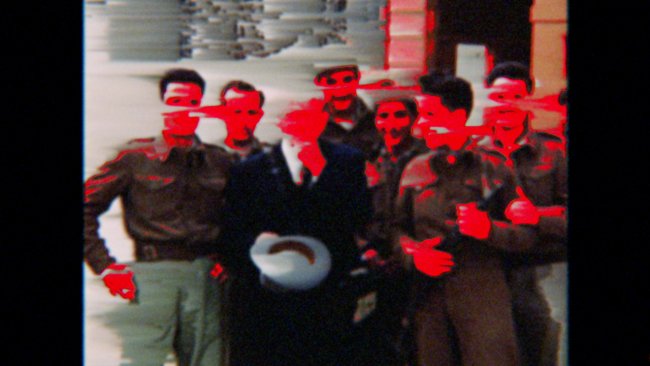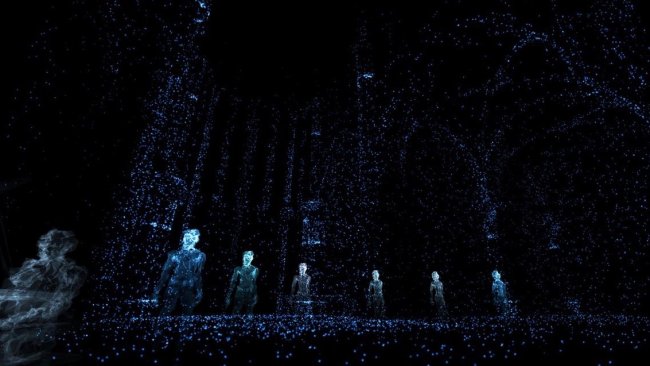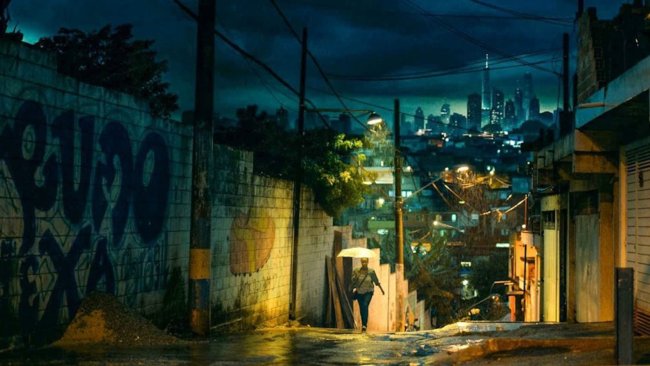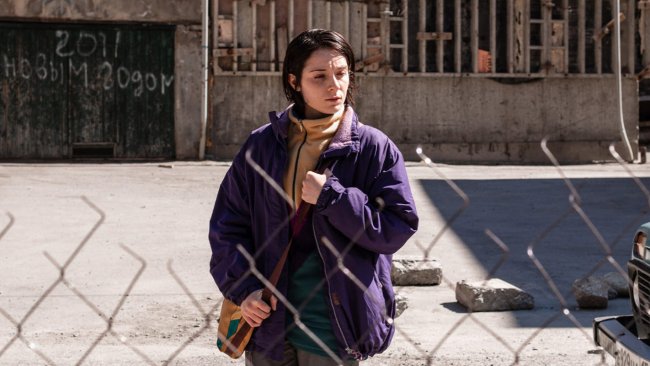About Endlessness
[…] Now, his narrative deals with bare essentials, and each piece of the usual portmanteau of scenes is treated as a one-line haiku, caustic indictments against political correctness and the emptiness of social life in rich countries.
[…] To take a look at some historical events and the banality of everyday life and mix them displaying a sense of humour that flirts with the uncanny as Andersson does, is one of the most outstanding feats of contemporary cinema, the evidence that Artifice is the best way to represent the Real.
[...] Ainsi s’explique le détour d’Andersson par la voie de l’hyperréalisme : dès lors que le grotesque réside dans les choses elles-mêmes – dans leur artificialité ontologique –, la réalité ne peut être sujette qu’à une interprétation hyperréaliste d’elle-même.
Text: Jorge Yglesias, Emilien Gür | Audio/Video: Lena von Tscharner

Podcast
Audio-Reading
Text: Jorge Yglesias | Reading: Amy Lombardi | Editing: Lena von Tscharner
Find a list of all our Podcasts here.
JORGE YGLESIAS
A new parade of losers and smaller-than-life personae are the heroes of Roy Andersson’s last movie, About Endlessness, whose philosophical title covers a new caricature of mankind made by this acute Swedish observer of human behaviour. After a successful debut in 1970 and a disheartened flop in his second work five years later, Andersson shot more than 400 extremely ingenious TV commercials before reappearing in 2000 when the Jury Prize in the Festival of Cannes was granted to his third picture, Songs from the Second Floor (2000), the first of a series of long features whose unique style has established him as one of the most original artists of cinema. A style forged in the quarter of a century he devoted to elaborate what Ingmar Bergman claimed the best ads ever made. The old, fat, ugly, bald and pale characters of these brief vignettes are the opposite of the perfect world that publicity would make people dream of.
For those familiarized with the cartoon-like world created by Andersson, About Endlessness is a more succinct variation on his main subjects. Now, his narrative deals with bare essentials, and each piece of the usual portmanteau of scenes is treated as a one-line haiku, caustic indictments against political correctness and the emptiness of social life in rich countries. In some way, About Endlessness is planned as an advertising campaign on how silly and rigid the rules of society are.
The fragmentary and concise storytelling of Andersson’s new movie shows us an opaque zoo of civilized zombies conveying a weird blend of affection, vulnerability and sorrows, whose absence of love for the neighbour sometimes is manifested by hilarious acts of violence. A priest who loses his faith go to a nonchalant psychoanalyst, an intolerant dentist abandons his jumpy patient, a distracted waiter pours wine on the table of an arrogant costumer, a jealous man slaps his wife in a market, three young women dance on a small road with imposed joy, a defeated Hitler bursts into a room of his bunker where some officers are part of a premonitory disarray or an interminable march of soldiers advancing through a snowstorm to a prison camp in Siberia: these are some of the fragments of life represented in the vignettes that follow each other in this film narrated hors-du-champ by a 21st century´s Scheherazade.
About Endlessness is an impressive piece of craftsmanship reliant on deep focus long shots, a chromatic treatment of muted blues, faded browns and yellow ochres, off-screen sounds, and a pitiless light that leaves no shadows for people to hide in, forcing them in to nakedness. Its meticulous use of space and layout, underlines the isolation of the pale-faced Andersson’s models. The austerity of Scandinavian design softens every inflexion —its focus on clean, simple lines, minimalism, and functionality constructs spaces free of clutter and ornamentation that emphasizes the defencelessness of the characters, arranged like shapes in a comic strip.
Called by David Bordwell a «dystopian Tati» for the comic meaning he infuses into the fake spaces built in his Studio 24, Roy Andersson is part of a very rich carnivalesque tradition. Author of a body of work of fruitful contrasts, we can name him a phlegmatic Fellini or a Tatian Bergman or a Bressonian Fellini, without forgetting the enormous influence of some masters of the Czech New Wave: Milos Forman, Jiri Menzel, Ivan Passer and Jaroslav Papousek; and, of course, the silent comedy, specially the perverse pathos of Harry Langdon. Buñuel, Brueghel, Daumier, the Expressionist and Surrealist painters also show up in the comic tragedies he conceives to talk about the significance of being human.
To take a look at some historical events and the banality of everyday life and mix them displaying a sense of humour that flirts with the uncanny as Andersson does, is one of the most outstanding feats of contemporary cinema, the evidence that Artifice is the best way to represent the Real. The hyperreality he invented to locate his human puppets is a disquieting stage where they strut and fret, stiff and slow, to remind us that Earth is neither a Hell nor a Paradise, but a ridiculous Purgatory where some people slouch towards a yellowish neutrality.
*
EMILIEN GÜR
Nul cinéaste ne nous est aussi contemporain que Roy Andersson. Pour le dire autrement, le septuagénaire suédois n’a pas son pareil pour voir, et surtout décrire, notre temps.
Son talent est double. Observateur et peintre à la fois, les tableaux qu’il compose nous plongent au cœur de l’ennui sourd et de la froide impersonnalité, caractéristiques d’un certain mode de vie occidental, dont le confort matériel et la distanciation sociale (cela bien avant toute pandémie) comptent parmi les attributs. Les tons pastel de ses images à l’artificialité exhibée sont ceux d’un jour dont le fard se serait lentement évanoui. La lumière rayonnante de l’été faiblit, comme le constate d’une voix atone un personnage absorbé dans la contemplation du ciel au début du film : « C’est déjà septembre… ». La vie se tarit à sa source, ce que l’éclairage livide des néons d’un bar ou d’un cabinet de dentiste dissimule trop mal. La société, elle, s’atrophie : les corps se guindent, la parole se bloque, même Dieu ne répond plus à l’appel. Il semblerait que l’Occident, une fois de plus, soit en crise ; ce dont s’amuse le cinéaste avec irrévérence.
Le style de Roy Andersson est décapant. Il combine l’hyperréalisme désincarné de Duane Hanson et la cruauté carnavalesque de James Ensor. L’artiste belge peignait des masques pour faire tomber ceux de la bourgeoisie de son temps. De nos jours, l’imposture s’affiche à visage découvert. Il ne s’agit plus de la démasquer, dès lors qu’elle s’imprime à la surface même de nos visages. Les masques que nous revêtons sont nos propres faces, et rien n’est plus factice que le réel. Ainsi s’explique le détour d’Andersson par la voie de l’hyperréalisme : dès lors que le grotesque réside dans les choses elles-mêmes – dans leur artificialité ontologique –, la réalité ne peut être sujette qu’à une interprétation hyperréaliste d’elle-même.
Roy Andersson n’a rien d’un cinéaste cynique. Sa vision, à la fois cruelle et douce, du désenchantement qui guette l’Europe trouve ses racines dans les heures les plus sombres de l’Histoire, soit l’inhumaine séquence que constitua la Deuxième Guerre mondiale. La société dont Andersson se rit des travers s’est reconstruite sur les ruines de Cologne, montrées dans un plan à la beauté oxymorique, qui donne à voir la ville détruite, filmée en surplomb, tandis qu’un couple enlacé flotte à travers le ciel. Reconstruction ô combien hâtive, suggère le réalisateur, aux yeux duquel il semble clair que ce bricolage maladroit, guidé par un rationalisme mortifère, ne tiendra pas sur la durée. La grâce du couple suspendu dans les airs indique quant à elle que nous pourrions faire mieux. Il faudra donc reconstruire l’Europe à nouveau, à partir d’une certaine idée de l’amour.
This article contains a third-party video. If you would like to watch the video, please adjust your settings.



